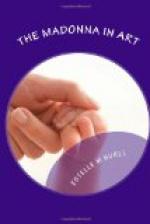[Illustration: BOTTICELLI.—MADONNA OF THE POMEGRANATE .]
In connection with the peculiar type of melancholy exhibited on the face of Botticelli’s Madonna, it will be of interest to refer to the work of Francia. The two artists were, in some points, kindred spirits; both felt the burden of life’s mystery and sorrow. Francia, as we have seen, imbibed from the works of Perugino something of the spirit of mysticism common to the Umbrian school. But while there is a certain resemblance between his Madonna and Perugino’s, the former has less of sentimentality than the latter, and more real melancholy. Like Botticelli’s Virgin, she acts her part half-heartedly, as if the sword had already begun to pierce her heart. Francia’s favorite Madonna subjects were of the higher order, the Madre Pia and the Madonna as Witness. In treating the latter, his Christ-child is always in keeping with the mother, a grave little fellow who gives the blessing with almost touching dignity. Enthroned Madonnas illustrating the theme are those of the Hermitage at St. Petersburg, of the Belvedere at Vienna, and the famous Bentivoglio Madonna in S. Jacopo Maggiore at Bologna. The last-named is one of the works which enable us to understand Raphael’s high praise of the Bolognese master. It is a noble composition, full of strong religious feeling.
[Illustration: MURILLO.—MADONNA AND CHILD.]
It is a long leap from the fifteenth to the seventeenth centuries, taking us from a period of genuine religious fervor in art, into an age of artificial imitation. In the midst of the decadence of old ideals and the birth of art methods entirely new, arose one who seemed to be the reincarnation of the old spirit in a form peculiar to his age and race. This was Murillo, the peasant-painter of Spain, than whom was never artist more pious, not even excepting the angelic brother of San Marco. He alone in the seventeenth century kept alive the pure flame of religious fervor, which had burned within the devout Italians of the early school. Through all his pictures of the Virgin and child we can see that the Madonna as the Christ-bearer is the ideal he always has in view. He falls short of it, not through any lack of earnestness, but because his type of womanhood is incapable of expressing such lofty idealism. His virgins are modelled upon the simple Andalusian maidens, sweet, timid, dark-eyed creatures. Their faces glow with gentle affection as they look wistfully out of the picture, or raise their eyes to heaven, as if dimly discerning the heights which they have never reached.
The Pitti Madonna is one of this sweet company, and perhaps the loveliest of them all. Both she and her beautiful boy are full of gentle earnestness, and if they are too simple-minded to realize what is in store for them, they are none the less ready to do the Father’s will.




